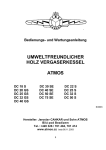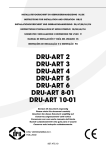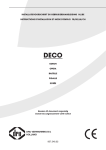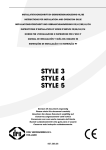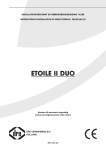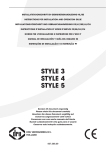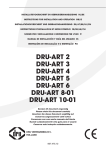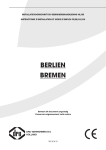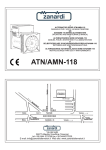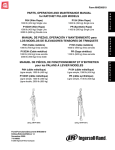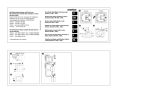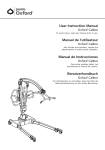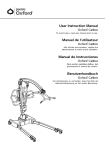Download DVS-2 ODEON OPERA BASTILLE ELYSÉE
Transcript
INSTALLATIEVOORSCHRIFT EN GEBRUIKERSHANDLEIDING NL/BE INSTRUCTIONS FOR INSTALLATION AND OPERATION GB/IE INSTALLATIONSVORSCHRIFT UND GEBRAUCHSANWEISUNG DE/AT/BE/LU/CH INSTRUCTIONS D’INSTALLATION ET MODE D’EMPLOI FR/BE/LU/CH DVS-2 ODEON OPERA BASTILLE ELYSÉE Bewaar dit document zorgvuldig Please retain this document carefully Bewahren Sie dieses Dokument sorgfältig auf Conservez soigneusement cette notice DRU VER WARMING B.V. HOLLAND 957.554.04 Hierbij verklaren wij dat de DRU modellen DVS-2 in overeenstemming zijn met het CE typeonderzoekscertificaat E 1490 en dat zij voldoen aan de Europese richtlijn inzake gastoestellen 90/396/EEC. We here by declare that the DRU models DVS-2 are in conformity with the types as described in EC type-certificate E 1490 and that they are in compliance with the European Council gas appliance directive 90/396/EEC. Hiermit erklären wir, dass die DRU-Modelle DVS-2 mit dem CE Typen-Untersuchungszertifikat übereinstimmen E 1490 und dass diese den Richtlinien für Gasgeräte 90/396/EEG entsprechen. Nous déclarons par la présente que les modèles DRU DVS-2 sont conformes au certificat d'examen de type CE E 1490 et qu'ils satisfont à la directive européenne relative aux appareils à gaz 90/396/CEE. INHOUD Monteren van de thermostaatvloer . . . . . . . . . . . . . .4 Plaatsen van de mantel . . . . . . . . . . . . . . . . . . . . . . . .4 Vloerplaat . . . . . . . . . . . . . . . . . . . . . . . . . . . . . . . . . . .4 In bedrijf stellen . . . . . . . . . . . . . . . . . . . . . . . . . . . . . .4 Kleinstand . . . . . . . . . . . . . . . . . . . . . . . . . . . . . . . . . .4 Waakvlambrander . . . . . . . . . . . . . . . . . . . . . . . . . . . .4 Gebruikershandleiding . . . . . . . . . . . . . . . . . . . . . . . . .5 Aansteken . . . . . . . . . . . . . . . . . . . . . . . . . . . . . . . . . .5 Doven . . . . . . . . . . . . . . . . . . . . . . . . . . . . . . . . . . . . . .5 Algemene opmerkingen . . . . . . . . . . . . . . . . . . . . . . . .6 Onderhoud en reiniging . . . . . . . . . . . . . . . . . . . . . . .6 Verkleuring van wanden en plafonds . . . . . . . . . . . . . .6 Eerste maal stoken . . . . . . . . . . . . . . . . . . . . . . . . . . .6 Extra bescherming . . . . . . . . . . . . . . . . . . . . . . . . . . . .6 Afdanken . . . . . . . . . . . . . . . . . . . . . . . . . . . . . . . . . . .6 Garantie . . . . . . . . . . . . . . . . . . . . . . . . . . . . . . . . . . . .6 Technische gegevens . . . . . . . . . . . . . . . . . . . . . . . . .27 Woord vooraf . . . . . . . . . . . . . . . . . . . . . . . . . . . . . . .2 Uitpakken . . . . . . . . . . . . . . . . . . . . . . . . . . . . . . . . . . .2 Aansluiten . . . . . . . . . . . . . . . . . . . . . . . . . . . . . . . . . .2 Installatievoorschrift . . . . . . . . . . . . . . . . . . . . . . . . . .2 Gassoort . . . . . . . . . . . . . . . . . . . . . . . . . . . . . . . . . . .2 Belangrijk . . . . . . . . . . . . . . . . . . . . . . . . . . . . . . . . . . .2 Algemeen . . . . . . . . . . . . . . . . . . . . . . . . . . . . . . . . . . .2 Installatie aan een wand van onbrandbaar materiaal .2 De standaard geveldoorvoer . . . . . . . . . . . . . . . . . . . .2 Montage van de geveldoorvoer . . . . . . . . . . . . . . . . . .2 De geveldoorvoer met telescopische inlaatpijp . . . . .3 Installatie van de geveldoorvoer met telescopische inlaatpijp . . . . . . . . . . . . . . . . . . . . . . . .3 Installatie aan een wand van brandbaar materiaal . . .3 Plaatsen van de aluminium schermplaat . . . . . . . . . . .3 Plaatsen van de convector . . . . . . . . . . . . . . . . . . . . . .3 Aansluiting van de gastoevoer . . . . . . . . . . . . . . . . . . .4 Gloeikooltjes . . . . . . . . . . . . . . . . . . . . . . . . . . . . . . . .4 DVS-2 1 N e d e r l a n d s INHOUD INSTALLATIE VOORSCHRIFT Woord vooraf Installatie aan een wand van onbrandbaar materiaal Bepaal de plaats van de convector die tegen een buitengevel en staand op de vloer geïnstalleerd moet worden. Leg de aluminium vloerplaat op de vloer en zet de convector, zonder mantel, erop. Schuif het toestel tegen de muur op de gewenste plaats. Op de achterkant van de convector is de montageplaat gemonteerd ((2) fig.1) die nu tegen de muur aan ligt. Teken de bovenkant en een zijkant van de montageplaat op de muur af. Na demontage van de montageplaat kan deze vervolgens als aftekenmal gebruikt worden voor het gat in de gevel. Geachte klant, Vriendelijk bedankt voor de aankoop van dit DRU product. Onze producten zijn ontwikkeld en gefabriceerd volgens de hoogst mogelijke kwaliteits-, prestatie- en veiligheidseisen. Hierdoor kunt u rekenen op jarenlang probleemloos gebruiksplezier. In dit boekje vindt u instructies voor installatie en gebruik van uw nieuwe toestel. Lees de instructies en gebruikershandleiding goed door, zodat u zich vertrouwd maakt met het toestel.Wilt u meer ondersteuning, neem dan contact op met uw leverancier. Om de mantel om het binnenwerk te kunnen hangen moet men rekening houden dat tussen een eventuele vensterbank en het toestel een vrije ruimte van minimaal 25 mm noodzakelijk is. Uitpakken Wanneer u klaar bent met uitpakken, dient de verpakking via de reguliere weg te worden afgevoerd. De standaard geveldoorvoer Maak een horizontaal gat in de muur met een diameter van ø 230mm voor doorvoering van de inlaatpijp. Zorg er voor dat de muurdoorvoer ongeveer 2º op afschot ligt. Aansluiten Dit toestel dient te worden aangesloten door een bevoegd installateur. De standaard geveldoorvoer is geschikt voor wanddiktes van 50-330 mm en de standaard verlengde doorvoer voor wanddiktes van 50-600 mm. Afhankelijk van de wanddikte dienen de in- en uitlaatpijp op lengte te worden gemaakt n.l. • lengte inlaatpijp = wanddikte + 20 mm. • lengte uitlaatpijp = wanddikte + 70 mm. INSTALLATIEVOORSCHRIFT Gassoort Dit toestel is bestemd voor het land en geschikt voor de gassoort dat is vermeld op de typeplaat. Controleer of de gassoort en de gasdruk ter plaatse overeenkomen met de vermelding op het typeplaatje. Houdt u aan de gasinstallatievoorschriften en eventuele plaatselijke voorschriften. Het toestel dient door een bevoegd installateur te worden aangesloten. De aan het muurrooster gemonteerde trekstangen kunnen na montage van de geveldoorvoer worden ingekort. Montage van de geveldoorvoer (fig. 1) Schuif de inlaatpijp (1) in de muuropening. Breng vanaf de buitenzijde het muurrooster met de twee trekstangen (4) in de inlaatpijp. Hang de montageplaat (2) om de inlaatpijp en druk deze vlak tegen de muur. Het merkteken "TOP" boven houden bij het plaatsen van het muurrooster. Om het toestel te laten werken op butaan of propaan dient het omgebouwd te worden door een bevoegd installateur. Een ombouwset is via hem te bestellen. Belangrijk • Zorg ervoor dat evt. overgordijnen of andere brandbare materialen minstens 50 cm van het toestel verwijderd zijn. • Let op! Aanraking van hete delen kan brandblaren veroorzaken! • Het toestel dient door een erkend installateur geïnstalleerd te worden. • Het plaatsen van een z.g. stoffilter op of onder de mantel is niet toegestaan. • Natte kleding, handdoeken e.d. niet op de kachel te drogen hangen! 1 5 2 3 6 4 358 Algemeen Het toestel kan zowel aan een wand van onbrandbaar materiaal (b.v. steen of beton), als aan een wand van brandbaar materiaal (b.v. hout) geïnstalleerd worden. 6 1 70 c- 38 3 fig. 1 2 1. Inlaatpijp 2. Montageplaat 3. Bevestigingsbeugel 4.Trekstang 5. Pakkingsring 6. Bevestigingsbout INSTALLATIE VOORSCHRIFT De geveldoorvoer met telescopische inlaatpijp Deze is geschikt voor wanddiktes van 250 - 440 mm zonder inkorten van de inlaatpijpdelen. Door de pijpdelen in te korten is deze geveldoorvoer geschikt te maken voor wanddiktes van 70 tot 250 mm. De uitlaatpijp dient op lengte te worden gemaakt volgens tabel. De aan het muurrooster gemonteerde trekstangen kunnen na montage van de geveldoorvoer worden ingekort. Installatie aan een wand van brandbaar materiaal Het aftekenen van de muurdoorvoer op de wand kan hetzelfde als bij een wand van onbrandbaar materiaal. Maak op het hart van het ronde gat in de montageplaat een vierkante opening door de gevel van 280 mm. Bij een dubbele wand de spouw goed opvullen zodat de delen niet samengedrukt worden. Bevestig aan de buitenkant van de gevel m.b.v. 4 schroeven de extra siluminplaat. De extra plaat voor doorvoer brandbare wand wordt op bestelling geleverd. De montage van de muurdoorvoer is verder zoals beschreven bij montage aan een wand van onbrandbaar materiaal. Indien voor wanddiktes van 70 tot 250 mm de telescopische inlaatpijp wordt toegepast dienen beide pijpdelen te worden ingekort n.l.: • het inlaatpijpdeel aan de muurroosterzijde gelijk aan de wanddikte • het pijpdeel aan de toestelzijde op een lengte = de wanddikte - 20 mm. LET OP: de pijpdelen niet afknippen aan de zijde waar de bevestigingsbeugeltjes zijn aangebracht. N.B.Voor de berekening van de lengte van de in- en uitlaatpijp dient ook de dikte van siluminplaat 15 te worden meegeteld. Detail muur bevestiging Plaatsen van de aluminium schermplaat De aluminium schermplaat dient bij installatie van de convector onder de voet van het binnenwerk geplaatst te worden. De plaat zo ver naar achteren schuiven dat de voorzijde gelijk ligt met de voorzijde van de plaatstalen voet. Plaatsen van de convector Schuif de uitlaatpijp in het muurrooster en zet de convector op de vloerschermplaat. De convector tegen de wand schuiven met de uitlaat over de uitlaatpijp en met de bevestigingsbeugels over de twee bouten van de montageplaat. Twee moeren aanbrengen en licht vastzetten. 38c-700 fig. 2 DVS-2 3 N e d e r l a n d s Installatie van de geveldoorvoer met telescopische inlaatpijp (fig. 1) Breng het muurrooster met de daaraan gemonteerde inlaatpijphelft van buitenaf in de gemaakte muuropening met "Top" naar boven bij het plaatsen van het muurrooster. Schuif de andere helft van de inlaatpijp door de montageplaat (2) en zorg daarbij dat de ingelaste bevestigingsbeugels (3) op de horizontale hartlijn liggen (zie de merktekens in de montageplaat) en om de omgezette montageplaatrand haken. Schuif de inlaatpijp helft van binnenuit door de gemaakte muuropening in het reeds aangebrachte inlaatpijp deel. Zorg daarbij dat de twee trekstangen (4) door de bevestigingsbeugels (3) steken. De montageplaat aandrukken tot tegen de wand. Breng de moeren aan op de trekstangen (4) en zet deze tegen de bevestigingsbeugels (3) handvast. Schuif de twee bevestigingsbeugels (3) zodanig over de trekstangen dat ze om de rand van de montageplaat en de inlaatpijp haken. Met twee moeren de muurdoorvoer vastdraaien terwijl tevens de montageplaat en het muurrooster in de goede positie gedraaid worden (de twee bouten op de montageplaat en de trekstangen horizontaal). De montageplaat op de plaats schuiven die vooraf op de muur is afgetekend. INSTALLATIE VOORSCHRIFT Aansluiting van de gastoevoer De aansluiting is 1/2" binnendraad. Gebruik in de toevoerleiding een gekeurde aansluitkraan met koppeling (voor Belgie moet deze B.G.V. gekeurd zijn). De aansluitkraan met koppeling dient buiten de mantel te worden geplaatst. Verder geldt: • Ontlucht de toevoerleiding voordat het toestel wordt vastgekoppeld. • De bedieningskraan mag niet verdraaid worden bij het aansluiten aan de gastoevoerleiding. • Vermijd spanningen op de bedieningskraan en leidingen. • Controleer de aansluitingen op gasdichtheid. Plaatsen van de mantel De mantel over het binnenwerk hangen met de achterrand in de mantelsteunen. Tevens dient het voorfront over de centreerpennen van de voetsteunen te vallen. Vloerplaat De vloerplaat onder het toestel schuiven met de uitsparingen om de voeten van het binnenwerk. In bedrijf stellen Het toestel is door de fabriek ingericht voor de gassoort zoals op het typeplaatje is aangegeven. De thermostaat regelt modulerend tussen ,volstand" en ,kleinstand" en bij een geringe warmtebehoefte in twee posities, n.l. ,kleinstand" of ,uit". Hierbij blijft de waakvlam steeds branden. De kleinstand kan alleen worden gecontroleerd wanneer de kamertemperatuur hoger is dan ca. 15° C (60° F). Gloeikooltjes Deze zijn vanuit de fabriek reeds gemonteerd.Wanneer deze moeten worden vervangen ga dan als volgt te werk: • Verwijder de 8 moeren. • Glasraam afnemen. • Verwijder de kapotte gloeikooltjes. • Plaats de gloeikooltjes gelijkmatig verdeeld op het raamwerk in de verbrandingskamer (fig. 3). • Glasraam terugplaatsen. • 8 moeren vastdraaien. Kleinstand De kleinstand is ingesteld op ± 20 % van het volverbruik. De kleinstandschroef is geheel ingedraaid en voorzien van de juiste kleinstandboring. Deze is niet instelbaar. Monteren van de thermostaatvoeler (fig. 3) Voor de thermostaatvoeler is een voelerhouder bijgeleverd die naast de convector op de plint of laag tegen de muur bevestigd dient te worden. Waakvlambrander De waakvlambrander heeft bij levering het juiste verbruik d.m.v. een spuitstuk dat zich in de waakvlambrander bevindt. De waakvlambrander behoeft niet te worden ingesteld. 80 0 10 9 70 8c 3 38c-993 fig. 4 fig. 3 4 GEBRUIKERSHANDLEIDING N e d e r l a n d s GEBRUIKERSHANDLEIDING Knop A is de regelknop (thermostaatknop). Knop B is de ontsteekknop. B C A Aansteken Draai het woord Pilot van de regelknop A tot precies tegenover het indicatiepunt C zoals op bovenstaande foto. Druk de regelknop in waardoor er gas naar de waakvlambrander stroomt. Door nu tevens de ontsteekknop B één of enkele malen in te drukken wordt de waakvlam ontstoken. De regelknop nog ca. 5 seconden ingedrukt houden om de beveiliging te activeren. Na het loslaten van de regelknop blijft de waakvlambrander branden. Door vervolgens de regelknop linksom te draaien via stand LO naar HI, wordt de hoofdbrander ontstoken. Op stand HI wordt de kamertemperatuur door de thermostaat op de hoogste waarde geregeld: op stand LO op de laagste waarde. De door u gewenste kamertemperatuur kan ongesteld worden door de regelknop tussen LO (laag) en HI (hoog) te draaien. Op stand Pilot blijft alleen de waakblambrander branden en gaat de hoofdbrander, ook bij lage kamertemperatuur, niet meer aan. Doven Draai de regelknop A op stand OFF. De gastoevoer naar de hoofd- en waakblambrander is nu afgesloten. Attentie: Indien de waakvlambrander, door welke oorzaak dan ook, is gedoofd dient enkele minuten te worden gewacht alvorens opnieuw te ontsteken. DVS-2 5 ALGEMENE OPMERKINGEN Eerste maal stoken Tijdens de eerste maal stoken kan er een onaangename geur ontstaan, die wordt veroorzaakt door het uitdampen van de lak. Dit verdwijnt na enkele uren. Daarom raden wij u aan het toestel de eerste maal op de hoogste stand te stoken terwijl u tevens het vertrek waarin de kachel staat goed ventileert. ALGEMENE OPMERKINGEN Onderhoud en reiniging Uw toestel dient eenmaal per jaar door een gekwalificeerd bedrijf te worden gecontroleerd, en waar nodig, hersteld of gereinigd. De controle en het onderhoud dient in ieder geval een goede en veilige werking van het toestel te omvatten. U kunt hiervoor gebruik maken van uw gasinstallateur of een gespecialiseerd onderhoudsbedrijf. Het verdient aanbeveling om vóór en tijdens het stookseizoen het toestel enkele malen stofvrij te maken. Bij het reinigen van de mantel geen bijtende of schurende middelen gebruiken. Lakbeschadigingen, bijvoorbeeld door het plaatsen van voorwerpen op of tegen de mantel, vallen buiten de garantie. Extra bescherming Indien het toestel in een vertrek geïnstalleerd wordt waar jonge kinderen of hulpbehoevende mensen zonder toezicht verblijven, is het wenselijk het toestel af te schermen. Afdanken Indien u het toestel vervangt of verwijdert, moet u het toestel via de reguliere weg afvoeren.Voordat tot demontage wordt overgegaan eerst de aansluitkraan met koppeling dichtdraaien. De koppeling tussen aansluitkraan en toestel losdraaien. Het gehele toestel kan nu worden gedemonteerd en afgevoerd. U kunt de mantel verwijderen door deze op te tillen en naar voren te schuiven. De binnenkant van het glasraam kunt U schoonmaken met een vochtige doek of met een niet-krassend reinigingsmiddel. Het glasraam kunt U wegnemen na het verwijderen van de vleugelmoeren. Een gebarsten of gebroken ruit dient vervangen te worden alvorens het toestel opnieuw in gebruik te nemen. Wanneer een gloeikooltje is gebroken of door andere oorzaken zich niet op de juiste plaats bevindt, dient dit direkt hersteld te worden. Garantie De garantie op uw DRU toestel wordt verleend via uw leverancier. In geval van storingen dient u altijd met hem contact op te nemen. Uw leverancier zal DRU inschakelen indien hij dit noodzakelijk acht. De fabrieksgarantie op uw toestel bedraagt 2 jaar na datum van aankoop. Let op: Bij het vervangen van het thermokoppel moet de wartel in het gasregelblok handvast gedraaid worden, waarna deze met een steeksleutel een kwartslag aangedraaid moet worden. Verkleuring van wanden en plafonds Bruinverkleuring is een vervelend probleem en is moeilijk op te lossen. Bruinverkleuring kan worden veroorzaakt door onder andere stofverbranding veroorzaakt door te weinig ventilatie, door het roken van sigaretten of het branden van kaarsen. Deze problemen kunnen worden voorkomen door: Het vertrek waar het toestel zich bevind goed te ventileren. Een goede richtlijn hiervoor is: Bij nieuwbouw : 3.24 m3 / uur per m2 vloeroppervlak van een vertrek. Bij bestaande bouw : 25.20 m3 / uur voor een vertrek. Maak zo weinig mogelijk gebruik van kaarsen en olielampjes en houd het verbrandingslontje zo kort mogelijk. Deze "sfeerbrengers" zorgen voor aanzienlijke hoeveelheden vervuilde en ongezonde roetdeeltjes in uw woning. Rook van sigaretten en sigaren bevat o.a. teerstoffen die bij verhitting eveneens op koudere en vochtige muren zullen neerslaan. Bij een nieuw gemetselde schouw of na een verbouwing wordt aanbevolen minimaal 6 weken te wachten voordat men gaat stoken, het bouwvocht moet namelijk geheel verdwenen zijn uit wanden, vloer en plafond. 6 CONTENTS Fitting the thermostat phial . . . . . . . . . . . . . . . . . . . .10 Floor plate . . . . . . . . . . . . . . . . . . . . . . . . . . . . . . . .10 Operations . . . . . . . . . . . . . . . . . . . . . . . . . . . . . . . . .10 The low setting . . . . . . . . . . . . . . . . . . . . . . . . . . . . .10 Pilot light burner . . . . . . . . . . . . . . . . . . . . . . . . . . . .10 User instructions . . . . . . . . . . . . . . . . . . . . . . . . . . . .10 Lighting . . . . . . . . . . . . . . . . . . . . . . . . . . . . . . . . . . . .10 Turning the heater off . . . . . . . . . . . . . . . . . . . . . . . .10 General notes . . . . . . . . . . . . . . . . . . . . . . . . . . . . . .11 Gas safety regulations (for installation & use), 1998 11 Cleaning and Maintenance . . . . . . . . . . . . . . . . . . . . .11 Discoloration of walls and ceiling . . . . . . . . . . . . . . .11 Lighting the heater for the first time . . . . . . . . . . . .11 Extra protection . . . . . . . . . . . . . . . . . . . . . . . . . . . .11 Disposal . . . . . . . . . . . . . . . . . . . . . . . . . . . . . . . . . . .11 Guarantee . . . . . . . . . . . . . . . . . . . . . . . . . . . . . . . . .11 Technical data . . . . . . . . . . . . . . . . . . . . . . . . . . . . . . .27 Foreword . . . . . . . . . . . . . . . . . . . . . . . . . . . . . . . . . . .8 Unpacking . . . . . . . . . . . . . . . . . . . . . . . . . . . . . . . . . . .8 Connection . . . . . . . . . . . . . . . . . . . . . . . . . . . . . . . . .8 Instructions for installation . . . . . . . . . . . . . . . . . . . . .8 Type of gas . . . . . . . . . . . . . . . . . . . . . . . . . . . . . . . . . .8 Important . . . . . . . . . . . . . . . . . . . . . . . . . . . . . . . . . . .8 General . . . . . . . . . . . . . . . . . . . . . . . . . . . . . . . . . . . .8 Installing against a non-combustible wall . . . . . . . . . .8 The standard wall duct . . . . . . . . . . . . . . . . . . . . . . . .8 Mon fitting the wall duct . . . . . . . . . . . . . . . . . . . . . . .8 The exterior wall duct with telescopic inlet pipe . . .9 Installation of the wall duct with telescopic inlet pipe . . . . . . . . . . . . . . . . . . . . . . . . . . .9 Installation against a combustible wall . . . . . . . . . . . .9 Positioning the aluminium shield . . . . . . . . . . . . . . . . .9 Positioning the convector . . . . . . . . . . . . . . . . . . . . . .9 Connection of the gas supply . . . . . . . . . . . . . . . . . .9 Glowing coals . . . . . . . . . . . . . . . . . . . . . . . . . . . . . . . .9 DVS-2 7 E n g l i s h CONTENTS INSTRUCTIONS FOR INSTALLATION Foreword Installation against a non-combustible wall Determine exactly where the convector is to be installed, against the outer wall and standing on the floor. Lay the aluminium floor plate on the floor and stand the convector on it, without the casing. Slide the appliance into the required position against the wall. On the back of the convector is a mounting plate ((2) fig.1) that will now be against the wall. Mark the top and sides of the mounting plate on the wall. By removing the mounting plate it will now serve as a stencil to mark the exact position for the hole in the outer wall. Dear Customer, We would like to thank you for buying this DRU product. Our products have been designed and produced to meet the highest possible quality, performance and safety requirements, allowing you to enjoy years of problem-free use. In this booklet you will find instructions for the installation and use of your new appliance. Please read these instructions and the manual carefully to familiarize yourself with the appliance. If you require any further support, please do not hesitate to contact your supplier. To be able to hang the casing over the interior, a minimal clearance of 25 mm must be allowed between the appliance and a windowsill or suchlike. Unpacking Once the heater has been unpacked, all packaging should be disposed of in the regular manner. The standard wall duct Drill a horizontal hole in the wall, ø 230mm in diameter, to take the air-supply pipe.The wall duct should slope at an angle of approx. 2º. Connection This appliance should be connected by a registered installer. The standard wall duct is suitable for walls with a thickness of 50 – 330 mm and the standard extended wall duct for walls with a thickness of 50 – 600 mm. Depending on the thickness of the wall, the inlet and outlet pipes should be made to length, i.e.: • length inlet pipe = wall thickness + 20 mm. • length outlet pipe = wall thickness + 70 mm. INSTRUCTIONS FOR INSTALLATION Type of gas This appliance can only be used and is only suitable for the country and the type of gas mentioned on the type identification tag. Please check that the local gas and pressure correspond with the specifications on the type identification tag. All regulations regarding gas installation, including any local regulations, must be observed at all times.The appliance is to be installed by a registered installer. The tension members fixed to the wall grid can be made to size after installation Mon Fitting the wall duct (fig. 1) Push the inlet pipe (1) through the hole in the wall. Working from the outside, fit the wall grille with the two tension rods (4) in the inlet pipe, keeping "TOP" at the top. Hang the mounting plate (2) round the inlet pipe and press it flat against the wall. Slide the two mounting brackets (3) over the tension rods so that they hook over the edge of the mounting plate and the inlet pipe. To operate the heater on bultane or propane, it should be converted by a registered installer. A conversion set can be ordered through him. Important • Keep curtains and any other flammable materials at least 50cm away form the appliance. • Caution! Touching the heater when hot can cause burns and blisters! • The appliance should be installed and maintained by a registered installer. • Do not install any so-called dust filter on or under the casing. • Do not hang wet clothes and towels etc. on the heater to dry. 1 5 2 3 6 4 358 General The appliance can be mounted either on a wall of incombustible material (e.g. stone or concrete) or on a wall of combustible material (e.g. wood). 6 1 70 c- 38 3 fig. 1 8 1. Inlet pipe 2. Mounting plate 3. Mounting bracket 4.Tension rod 5. Packing washer 6. Mounting bolt INSTRUCTIONS FOR INSTALLATION The exterior wall duct with telescopic inlet pipe This is suitable for wall thicknesses of 250 – 440 mm without shortening the parts of the inlet pipe. By shortening the pipe’s parts, this exterior wall duct can be adapted for thicknesses of 70 – 250 mm.The outlet pipe should be adjusted.The tension members attached to the wall grid can be shortened after the wall duct has been mounted. If the telescopic inlet pipe is applied for wall thicknesses of 70 – 250 mm, both parts of the pipe should be shortened, i.e.: • the part of the inlet pipe on the side of the wall grid equal to the thickness of the wall • the part of the pipe on the side of the heater to a length equalling the wall thickness minus 20 mm. N.B. To calculate the length of the inlet and outlet pipe, the thickness of siluminplate (15) should be included. Positioning the aluminium shield When installing the convector the aluminium shield should be placed under the foot of the interior. Slide the shield back far enough so that the front is level with the front of the steel foot. CAUTION: do not cut the pipe parts on the side where the fastening clamps have been applied. Positioning the convector Slide the outlet pipe into the wall grille and stand the convector on the floor plate. Slide the convector against the wall so that the outlet fits over the outlet pipe and the two mounting brackets over the bolts on the mounting plate. Screw the two nuts on lightly. Installation of the wall duct with telescopic inlet pipe (fig. 1) From the outside, put the wall grid, together with the attached half inlet pipe into the created wall opening, keeping "Top" up when placing the wall grid. Slide the other half of the inlet pipe through the mounting sheet (2), making sure that the inserted fastening clamps (3) lie on the horizontal centre line (see the marks in the mounting sheet).They should catch on the turned-back edge of the mounting sheet. From the inside, slide the half inlet pipe through the created wall opening into the part of the inlet pipe already mounted.While doing so, make sure the the two tension members (4) stick through the fastening clamps (3). Press the mounting sheet up to the wall. Appply the screw-nuts onto the tension members (4) and tighten them by hand against the fastening clamps (3). Connection of the gas supply The connection has a 1/2" inside thread. An approved connecting tap with coupling should be used in the supply pipe (For Belgium this should be B.G.V. approved).The connecting tap with coupling should be fitted outside the casing. Furthermore: • Expel all air from the supply pipes/hoses before coupling to the appliance. • Do not turn the coupling tap when connecting it to the gas supply. • Avoid any pressure on the control tap and pipes. • Check that all connections are gastight. Detail of the wall mounting Glowing coals The coals have already been fitted in the factory. Should they need replacing: • Remove the 8 nuts. • Remove the glass. • Remove the broken coals. • Evenly distribute the glowing coals on the grille in the combustion chamber (fig. 3). • Replace the glass. • Replace and tighten the 8 nuts. 38c-700 fig. 2 38c-993 fig. 3 DVS-2 9 E n g l i s h Installation against a combustible wall Marking the position of the wall duct on the wall is done in the same way as for a non-combustible wall. Make a 280 mm square hole through the outer wall, at the centre of the round hole in the mounting plate. If it is a cavity wall, fill the cavity well so that the sections do not get compressed. Fit the extra silumin plate with 4 screws onto the outside of the wall. This extra plate, to enable the duct to be used on a combustible wall, is available as a separate order. The wall duct is then fitted in the same manner as described for a non-combustible wall. Screw the wall duct firmly into position with two nuts while turning the mounting plate and the wall grille to the correct position (the two bolts on the mounting plate and the tension rods should be horizontal). Slide the mounting plate into the position previously marked on wall. INSTRUCTIONS FOR INSTALLATION USER INSTRUCTIONS Fitting the thermostat phial (fig. 3) Locate the thermostat phial with the supplied bracket to the kicking board close to the heater.When doing so take care to avoid damaging the thermostat phial or capillary. USER INSTRUCTIONS Button A is the control button (thermostat button). Button B is the ignition button. Fitting the casing Hang the casing over the interior, with the back edge in the casing supports. The front should drop over the centring pins on the foot supports. Floor plate Slide the floor plate under the appliance, positioning the recesses around the feet of the interior. B Operations The manufacturer has made the appliance suitable for the type of gas as indicated on the type identification tag.The thermostat regulates modulatingly between "full power setting" and "low power setting" and , when little heat is required, in two settings, i.e. "low" or "off". In this situation, the pilot light keeps burning.The "low" setting can only be checked when the room temperature is higher than ± 15°C (60°F). C A Lighting Turn the word ‘Pilot’ on control button A to exactly opposite point C, as shown above. Press the control button to allow gas to flow to the pilotlight. Now press the ignition button (B) several times to ignite the pilot light. Press the control button for approx. 5 seconds to activate the safety device. When the control button is released the pilot light will remain alight. Now turn the control button to the left, through LO to HI, to ignite the main burner. Set to HI, the thermostat will adjust the required room temperature to the maximum temperature, and set to Low, to the minimum temperature. You can adjust the required room temperature by setting the control button to anywhere between LO and HI. Set to ‘Pilot’, only the pilot light will burn.The main burner will no longer ignite, not even at low room temperatures. The low setting The low setting has been adjusted to ± 20% of the full consumption.The low setting screw has been fully tightened and is supplied with the correct low setting bore. This is not adjustable. Pilot light burner Upon delivery, the pilot light burner has the correct consumption by means of a nozzle inside the pilot light burner.The pilot light burner needs no adjustment. Turning the heater off Turn the control button (A) to OFF.The gas supply to both the main burner and the pilot light will now be shut off. NB: If, for any reason, the pilot light goes out, wait a few minutes before relighting it. 80 0 10 09 -7 c 38 fig. 4 10 GENERAL NOTES structions / renovations done, you are advised to wait at least 6 weeks before lighting your fire, to allow the walls, floor and ceiling to dry out completely. Gas Safety Regulations (for installation & use) 1998 In your own interest and that of safety, it is law that all gas appliances are installed by competent persons in accordance with the above regulations. Failure to install appliances correctly could lead to prosecution. Lighting the heater for the first time There can be an unpleasant smell when you light the heater for the first time.This is caused by the varnish evaporating and will disappear after a few hours.We therefore advise you, on initial use, to heat the appliance at the highest setting while ventilating the room it is installed in well. The casing can be removed by lifting it and sliding it forwards. The inside of the glass can be cleaned with a damp cloth or with a non-abrasive detergent. To remove the glass, unscrew the wing nuts. A cracked or broken glass front should be replaced before the heater is used again. If a coal is broken or for any other reason no longer in the correct position, it should be moved immediately. Extra protection This heater meets the normal safety standards regarding surface temperatures, but physical contact with heated surfaces should be avoided where possible. An additional guard is recommended to protect young children and elderly, infirmed or handicapped people. NB: The Confederation of Registered Gas Installers, whose members are identified by the emblem shown here, are all required to work to the recognised standards. Disposal When replacing or otherwise removing the appliance, it should be disposed of in compliance with current regulations. Cleaning and Maintenance The appliance should be inspected once a year by a qualified company, and cleaned and/or repaired as necessary. The inspection and maintenance must at least ensure that the appliance is working correctly and safely.This can be done by your own gasinstaller or a specialised maintenance company.You are recommended to free the heater of dust before and occasionally during the heating season.Do not use abrasives when cleaning the heater. Damage to the casing varnish, caused by anything being put on the appliance, is not covered by the guarantee. Shut off the connecting tap with coupling before commencing disassembly. Undo the coupling between the connecting tap and the appliance.The whole appliance can now be disassembled and removed. Guarantee The warranty for your DRU appliance will be provided by your supplier. In case of malfunctions, you should always contact him.You supplier will contact DRU if he feels this is necessary.The factory warranty for your appliance is valid for 2 years after date of purchase. NB: When replacing the pilot light burner, the coupling nut in the gas control block should first be tightened by hand and then tightened a quarter-turn with an open-ended spanner. Discoloration of walls and ceiling Brown discoloration is an annoying problem, which is difficult to solve. It can be caused by dust burning as a result of poor ventilation, for example, or by cigarette smoke or candles. These problems can be avoided by ensuring that the room the heater is in is properly ventilated. A good guideline for ventilation is: New buildings : 3.24 m3 / hour per m2 floor surface of the room. Existing buildings : 25.20 m3 / hour for a room. Use candles and oil lamps as little as possible, keeping the wick as short as possible.While they enhance the atmosphere, candles and oil lamps also cause the formation of large quantities of unhealthy soot particles in your home. Cigarette and cigar smoke contains tar, which upon heating will precipitate on cold or damp walls. If you have a newly cemented chimney or have had any other recon- DVS-2 11 E n g l i s h GENERAL NOTES 12 INHALT Glühkohle . . . . . . . . . . . . . . . . . . . . . . . . . . . . . . . . . .16 Montieren des Thermostatfühler . . . . . . . . . . . . . . .16 Anbringen des Mantels . . . . . . . . . . . . . . . . . . . . . . .16 Bodenplatte . . . . . . . . . . . . . . . . . . . . . . . . . . . . . . . .16 Inbetriebnahme . . . . . . . . . . . . . . . . . . . . . . . . . . . . .16 Kleinstand . . . . . . . . . . . . . . . . . . . . . . . . . . . . . . . . .16 Zündflammenbrenner . . . . . . . . . . . . . . . . . . . . . . . .16 Gebrauchsanweisung Gasregelblock Eurosit . . . . . .17 Zünden . . . . . . . . . . . . . . . . . . . . . . . . . . . . . . . . . . . .17 Ausschalten . . . . . . . . . . . . . . . . . . . . . . . . . . . . . . . .17 Allgemeine Bemerkungen . . . . . . . . . . . . . . . . . . . . .18 Wartung und Reinigung . . . . . . . . . . . . . . . . . . . . . . .18 Verfärbung von Wänden und Decken . . . . . . . . . . . .18 Zum ersten Mal heizen . . . . . . . . . . . . . . . . . . . . . . .18 Extra Schutz . . . . . . . . . . . . . . . . . . . . . . . . . . . . . . . .18 Entsorgen . . . . . . . . . . . . . . . . . . . . . . . . . . . . . . . . . .18 Garantie . . . . . . . . . . . . . . . . . . . . . . . . . . . . . . . . . . .18 Technische Daten . . . . . . . . . . . . . . . . . . . . . . . . . . . .27 Einige kurze Worte . . . . . . . . . . . . . . . . . . . . . . . . . .14 Auspacken . . . . . . . . . . . . . . . . . . . . . . . . . . . . . . . . .14 Anschluss . . . . . . . . . . . . . . . . . . . . . . . . . . . . . . . . . .14 Installationsvorschrift . . . . . . . . . . . . . . . . . . . . . . . . .14 Gassorte . . . . . . . . . . . . . . . . . . . . . . . . . . . . . . . . . .14 Wichtig . . . . . . . . . . . . . . . . . . . . . . . . . . . . . . . . . . . .14 Allgemein . . . . . . . . . . . . . . . . . . . . . . . . . . . . . . . . . .14 Installation an eine Wand von nicht brennbarem Material . . . . . . . . . . . . . . . . . . . . . . . . . . . . . . . . . . .14 Giebeldurchfuhr in Standardausführung . . . . . . . . . .14 Tage der Giebeldurchfuhr . . . . . . . . . . . . . . . . . . . . .15 Giebeldurchführung mit Teleskopeinlassrohr . . . . . .15 Installation der Giebeldurchführung mit Teleskopeinlassrohr . . . . . . . . . . . . . . . . . . . . . . . . . .15 Installation an eine Wand von brennbarem Material 15 Aufstellung der aluminium Schutzplatte . . . . . . . . . .15 Aufstellung des Kovektors . . . . . . . . . . . . . . . . . . . . .15 Anschluss der Gaszuleitung . . . . . . . . . . . . . . . . . . . .16 DVS-2 13 D e u t s c h INHALT INSTALLATIONSVORSCHRIFT Einige kurze Worte Allgemein Das Gerät kann sowohl an eine Wand von nicht brennbarem Material (z. B. Stein oder Beton), als auch an eineWand von brennbarem Material (z. B. Holz) installiert werden. Sehr geehrter Kunde, Herzlichen Dank für den Kauf dieses DRU Produktes. Unsere Produkte sind nach den höchst möglichen Qualitäts- Leistungs- und Sicherheitsanforderungen entwickelt und fabriziert. Hierdurch haben Sie jahrelanges, problemloses Gebrauchsvergnügen. Installation an einer wand von nicht brennbarem Material Bestimmen Sie den Platz des Konvektors, der an einen Außengie-bel und auf dem Boden installiert werden muß. Legen Sie die Aluminium-Bodenplatte auf den Boden und stellen Sie den Konvektor, ohne Mantel, darauf . Schieben Sie das Gerät an die Mauer auf den gewünschten Platz. Die Montageplatte ist an die Rückseite des Konvektors mon-tiert ((2) fig 1), die nun an der Mauer anliegt. Zeichnen Sie die Oberkante und eine Seite der Montageplatte an der Mauer ab. Nach Demontage der Montageplatte kann diese als Muster ge-braucht werden, um das Loch im Giebel anzuzeichnen. Hacken und Bohren Sie ein Loch von 230 mm horizontal durch den Giebel. In diesem Buch finden Sie Instruktionen zur Installation und zum Gebrauch Ihres neuen Gerät. Lesen Sie die Instruktionen und die Gebrauchsanleitung gut nach, so daß Sie sich mit dem Gerät vertraut machen können. Möchten Sie mehr Unterstützung haben, nehmen Sie dann Kontakt mit Ihrem Lieferanten auf. Auspacken Nach dem Auspacken muss die Verpackung auf dem regulären Weg entsorgt werden. Anschluss Dieses Gerät muß von einem zugelassenen Installateur angeschlossen werden. Um den Mantel um die Innenteile hängen zu können, muß man daran denken, daß zwischen einer eventuellen Fensterbank und dem Gerät ein freier Raum von minimal 25 mm nötig ist. Giebeldurchfuhr in Standardausführung Machen Sie ein horizontales Loch mit einem Durchmesser von Ø 230 mm zum Durchführen des Einlaßrohrs in die Mauer. Sorgen Sie bitte dafür, daß die Mauerdurchfuhr eine Neigung von ungefähr 2° hat. INSTALLATIONSVORSCHRIFT Gassorte Dieses Gerät ist bestimmt und geeignet für die auf der Typenplatte genannten Land und Gassorte. Kontrollieren Sie, ob die örtliche Gassorte und der Gasdruck mit dem der Typenplatte übereinstimmt. Halten Sie sich an die Gasinstallationsvorschriften und eventuelle örtliche Vorschriften. Das Gerät muss von einem anerkannten Installateur angeschlossen werden. Die Standard Giebeldurchführung ist für Wände von 50330 mm und die Standardverlängerte Durchführung für Wandstärken von 50-600 mm. Abhängig von der Wandstärke muss das Ein- und Auslassrohr auf Länge gesägt werden, nämlich: • Länge Einlassrohr = Wandstärke + 20 mm • Länge Auslassrohr = Wandstärke + 70 mm Um das Gerät auf Butan oder Propan arbeiten zu lassen, muss es von einem anerkannten Installateur umgebaut werden. Ein Umbausatz kann bei ihm bestellt werden. Die an den Mauerrost montierten Ziehstangen können nach der Montage auf Länge gesägt werden. Wichtig • Sorgen Sie dafür, dass Gardinen und andere brennbare Materialien mindestens 50 cm vom Gerät entfernt sind. • Achtung! Anfassen von heissen Teilen kann Brandblasen verursachen! • Das Gerät muss von einem anerkannten Installateur installiert und gewartet werden. • Das Anbringen eines sogenannten Staubfilters auf oder unter dem Mantel ist nicht erlaubt. • Nasse Kleidung, Handtücher u. Ä. Nicht zum Trocknen über den Ofen hängen. 1 5 2 3 6 358 4 6 1 70 c- 38 3 fig. 1 14 1. Einfuhrrohr 2. Montageplatte 3. Befestigungsbügel 4. Zugstange 5. Dichtungsring 6. Befestigungsbolzen INSTALLATIONSVORSCHRIFT Installation der Giebeldurchführung mit Teleskopeinlassrohr (fig. 1) Bringen Sie den Mauerrost und die daran montierte Einlassrohrhälfte von aussen in die gemachte Maueröffnung , beim Anbringen des Mauerrostes muss "Top" nach oben weisen. Schieben Sie die andere Hälfte des Einlassrohrs durch die Montageplatte (2) und sorgen Sie dafür, dass die eingelassenen Befestigungsbügel (3) auf der horizontalen Mittellinie liegen (siehe Markierung in der Montageplatte) und um die umgesetzte Montageplatte haken. Schieben Sie die Einlassrohrhälfte von innen durch die gemachte Maueröffnung in das bereits angebrachte Einlassrohrteil. Sorgen Sie dafür, dass die zwei Ziehstangen (4) durch die Befestigungsbügel (3) gesteckt werden. Die Montageplatte bis zur Wand andrücken. Bringen Sie die Muttern an den Ziehstangen an (4) und setzen Sie diese handfest an die Befestigungsbügel (3). Giebeldurchführung mit Teleskopeinlassrohr Diese ist für Wandstärken von 250 – 440 mm ohne Verkürzen der Einlassrohrteile geeignet.Wenn Sie die Rohrteile verkürzen, ist diese Giebeldurchführung für Wandstärken von 70 bis 250 mm geeignet. Das Auslassrohr muss auf Länge gesägt werden (siehe Tabelle). Die an den Mauerrost montierten Ziehstangen können nach Montage der Giebeldurchführung gekürzt werden. Falls für Wandstärken von 70 bis 250 mm das Teleskopeinlassrohr gebraucht wird, müssen beide Rohrteile gekürzt werden, nämlich: • das Einlassrohr an der Mauerrostseite gleich der Wanddicke • der Rohrteil an der Geräteseite, auf eine Länge gleich der Wanddicke -20 mm Installation an eine Wand von brennbarem Material Das Anzeichnen der Mauerdurchfuhr an die Wand kann auf dieselbe Weise wie bei einer Wand von nicht brennbarem Material erfolgen. Machen Sie in der Mitte des runden Lochs der Montageplatte eine viereckige Öffnung durch den Giebel von 280 mm. Bei einer doppelten Wand den Zwischenraum gut auffüllen, sodaß die Teile nicht zusammengedrückt werden. Befestigen Sie an der Außenseite des Giebels mittels 4 Schrauben die extra Siluminplatte. Die extra Platte zur Durchfuhr bei einer brennbaren Wand wird auf Bestellung geliefert. Die Montage der Mauerdurchfuhr ist weiterhin so wie bei der Montage an einer Wand von nicht brennbarem Material. Achtung: Die Rohrteile nicht an der Seite abschneiden, an der die Befestigungsbügel angebracht sind. N.B. Zur Berechnung der Länge des Ein- und Auslassrohrs muss auch die Dicke der Siluminplatte (15) mitgerechnet werden. Detail Mauerbefestigung Aufstellung der aluminium Schutzplatte Die Aluminium-Schutzplatte muß bei der Installation des Konvektors unter den Fuß der Innenausstattung des Ofens geschoben werden. Die Platte bitte so weit nach hinten schieben, daß die Vorderseite davon mit der Vorderseite des stählernen Fußes gleichliegt. Aufstellung des Konvektors Schieben Sie das Abfuhrrohr in den Mauerrost und stellen Sie den Konvektor auf die Bodenschutzplatte. Den Konvektor an die Wand schieben und zwar: Mit der Abfuhr über das Abfuhrrohr und mit den Befestigungsbügeln über die zwei Bolzen der Montageplatte. Zwei Muttern anbringen und leicht festschrauben. 38c-700 fig. 2 DVS-2 15 D e u t s c h Tage der Giebeldurchfuhr (fig. 1) Schieben Sie das Einfuhrrohr (1) in die Maueröffnung. Bringen Sie von der Außenseite aus den Mauerrost mit den zwei Zugstangen (4) in das Einfuhrrohr. Hängen Sie die Montageplatte (2) um das Einfuhrrohr und drücken Sie diese flach an die Mauer. Die Markieren "TOP’ beim Anbringen des Mauerrostes oben halten. Schieben Sie die zwei Befestigungsbügel (3) so über die Zugstan-gen, daß sie um den Rand der Montageplatte und das Einfuhrrohr haken. Mit zwei Muttern die Mauerdurchfuhr festschrauben, während dabei gleichzeitig die Montageplatte und der Mauerrost in die rich-tige Position gedreht werden (die zwei Bolzen auf der Montage-platte und die Zugstangen horizontal). Die Montageplatte auf ihren Platz schieben, der vorher auf die Mauer gezeichnet wurde. INSTALLATIONSVORSCHRIFT Anschluss der Gaszuleitung Der Anschluß ist 1/2" Innengewinde. Benutzen Sie bei der Zufuhrleitung einen geprüften Anschlußhahn mit Koppelung (für Belgien muß dieser B.G.V. geprüft sein). Der Anschlußhahn mit Koppelung muß außerhalb des Mantels angebracht werden.Weiterhin gilt: • Entlüften Sie die Zufuhrleitung, bevor das Gerät daran festgekoppelt wird. • Der Bedienungshahn darf beim Anschließen an die Gaszufuhrleitung nicht verdreht werden. • Vermeiden Sie Spannungen auf Bedienungshahn und Leitungen. • Kontrollieren Sie die Anschlüsse auf Gasdichtheit. Anbringen des Mantels Den Mantel über die Innenausstattung mit dem hinteren Rand in die Mantelstützen hängen. Die Vorderfront muß über die Zen-trier-zapfen der Fußstützen fallen. Bodenplatte Die Bodenplatte mit den Aussparungen um die Füße der Innenein-richtung unter das Gerät schieben. Inbetriebnahme Das Gerät ist von der Fabrik für die Gasssorte, die auf der Typenplatte steht, eingerichtet. Der Thermostat regelt modulierend zwischen „Vollstand" und „Kleinstand" und bei geringem Wärmebedarf in zwei Positionen, nämlich „Kleinstand" oder „aus". Hierbei brennt die Zündflamme immer. Der Kleinstand kann nur kontrolliert werden, wenn die Zimmertemperatur höher ist als ca. 15° C (60° F). Glühkohle Diese sind bei der Produktion des Kamines bereits montiert worden.Wenn es notwendig ist die zu ersetzten, arbeite dann wie folgt: Deze zijn vanuit de fabriek reeds gemonteerd.Wanneer deze moeten worden vervangen ga dan als volgt te werk: • Die 8 Schrauben entfernen. • Das Glasfenster abnehmen. • Die zerbrochenen Glühkohlen entfernen. • Die Glühkohlen gleichmässig verteilen auf die Gerippe im Brennkammer (fig. 3). • Das Glasfenster zurücksetzen. • Die 8 Schrauben wieder montieren. Kleinstand Der Kleinstand ist auf ± 20 % des Vollverbrauchs eingestellt. Die Kleinstandschraube ist vollkommen eingedreht und mit der richtigen Kleinstandbohrung versehen. Diese ist nicht einstellbar. Zündflammenbrenner Der Zündflammenbrenner hat bei der Lieferung mittels Spritzdüse, die sich im Zündflammenbrenner befindet, den richtigen Verbrauch. Der Zündflammenbrenner braucht nicht eingestellt zu werden. Montieren des thermostatfühler (fig. 3) Für den Thermostatfühler ist ein Fühlerhalter beigeliefert, der neben dem Konvektor an der Fußleiste oder niedrig an der Mauer befestigt werden muß. 80 0 10 09 -7 c 38 38c-993 fig. 4 fig. 3 16 GEBRAUCHSANWEISUNG D e u t s c h GEBRAUCHSANWEISUNG GASREGELBLOCK EUROSIT Knopf A ist der Regelknopf (Thermostatknopf). Knopf B ist der Zündknopf. B C A Zünden Drehen Sie das Word Pilot des Regelknopfes A genau gegenüber zum Indikationspunkt C, wie auf oben stehender Zeichnung. Drücken Sie den Regelknopf ein, wodurch Gas zum Zündflammenbrenner strömt. Wenn Sie nun gleichzeitig den Zündknopf B ein oder mehrere Male eindrücken, wird die Zündflamme gezündet. Den Regelknopf noch ca. 5 Sekunden eingedrückt halten, um die Sicherungsautomatik zu aktivieren. Nach dem Loslassen des Regelknopfes bleibt der Zündflammenbrenner brennen. Indem Sie danach den Regelknopf links herum drehen über Stand LO nach HI wird der Hauptbrenner gezündet. Auf Stand HI wird die Zimmertemperatur durch den Thermostat auf den höchsten Wert geregelt: auf Stand LO auf den niedrigsten Wert. Die von Ihnen gewünschte Zimmertemperatur kann umgestellt werden, indem Sie den Regelknopf zwischen LO (niedrig) und HI (hoch) drehen. Auf Stand Pilot bleibt nur der Zündflammenbrenner brennen und der Hauptbrenner geht auch bei niedriger Zimmertemperatur nicht mehr an. Ausschalten Drehen Sie den Regelknopf A auf Stand OFF. Die Gaszufuhr zum Haupt- und Zündflammenbrenner ist nun abgeschlossen. Achtung: Sollte der Zündflammenbrenner, ganz gleich durch welche Ursache ausgeschaltet sein, muss einige Minuten gewartet werden, bevor aufs Neue gezündet wird. DVS-2 17 ALLGEMEINE BEMERKUNGEN Zum ersten Mal heizen Wenn zum ersten Mal mit dem Gerät geheizt wird, kann ein unangenehmer Geruch entstehen. Dieser wird durch Lackdämpfe verursacht und verschwindet nach einigen Stunden von selbst.Wir empfehlen Ihnen deshalb, das Gerät bei der ersten Inbetriebnahme in den höchsten Stand zu stellen, wobei Sie gleichzeitig den Raum, in dem der Ofen steht, gut lüften. ALLGEMEINE BEMERKUNGEN Wartung und Reinigung Ihr Gerät muss einmal pro Jahr von einem qualifizierten Betrieb kontrolliert werden und falls nötig, repariert oder gereinigt werden. Die Kontrolle und die Wartung muss auf jeden Fall eine gute und sichere Funktion des Gerätes garantieren. Sie können hierfür von Ihrem Gasinstallateur oder einem spezialisierten Reparaturbetrieb Gebrauch machen. Es wird empfohlen, vor und während der Heizperiode das Gerät einige Male staubfrei zu machen. Beim Reinigen des Mantels keine beissenden Reinigungsmittel gebrauchen. Lackschäden des Mantels, durch Aufstellen von Gegenständen auf das Gerät, gehören nicht zur Garantie. Extra Schutz Sollte das Gerät in einem Raum installiert sein, in dem sich unbeaufsichtigte kleine Kinder oder hilfsbedürftige Menschen aufhalten, sollte das Gerät nach Möglichkeit abgeschirmt werden. Entsorgen Sollten Sie das Gerät ersetzen oder entfernen, muss es auf dem regulären Weg geschehen. Bevor zur Demontage übergegangen wird, erst den Anschlusshahn mit Koppelung zudrehen. Die Koppelung zwischen Anschlusshahn und Gerät lösen. Das ganze Gerät kann nun demontiert und entfernt werden. Sie können den Mantel entfernen, indem Sie ihn anheben und nach vorne schieben. Die Innenseite des Glasfensters können Sie mit einem feuchten Tuch, oder mit nicht kratzendem einigungsmittel säubern. Das Glasfenster können Sie nach dem Entfernen der Flügelmuttern herausnehmen. Eine zerbrochene oder gesprungene Scheibe muß ersetzt werden, bevor Sie das Gerät in Gebrauch nehmen. Wenn eine Glühkohle zerbrochen, oder sich durch andere Ursachen nicht auf dem richtigen Platz befindet, muß diessofort herstellt werden. Garantie Für die Garantie auf Ihr DRU-Gerät ist Ihr Lieferant zuständig. Bei Störungen wenden Sie sich bitte auf jeden Fall an ihn. Ihr Lieferant schaltet DRU ein, wenn er das für notwendig hält. Die fabriksseitige Garantie auf Ihr Gerät beträgt zwei Jahre ab dem Kaufdatum. Achtung: Beim Ersetzen des Zündflammenbrenners muß der Warl im Gasregelblock erst handfest angedreht und danach mit einem Steckschlüssel und einer Vierteldrehung gut festgedreht werden. Verfärbung von Wänden und Decken Braunverfärbung ist ein ärgerliches Problem und ist schwierig aufzulösen. Braunverfärbung kann z. B. durch Staubverbrennung verursacht werden, durch zu wenig Ventilation, durch rauchen von Zigaretten oder brennende Kerzen. Diese Probleme können vermieden werden, wenn der Raum, in dem sich das Gerät befindet, gut ventiliert wird. Eine gute Richtlinie hierfür ist: Bei Neubau : 3.24 m3 / Stunden pro m2 Bodenoberfläche eines Raums Bei bestehendem Bau : 25.20 m3 / Stunden für einen Raum. Gebrauchen Sie möglichst wenig Kerzen und Öllampen und halten Sie den Verbrennungsdocht so kurz wie möglich. Diese "Stimmungsmacher" sorgen für ziemliche Mengen schmutziger und ungesunder Rußteilchen in Ihrer Wohnung. Rauch von Zigaretten und Zigarren enthält u. a.Teer, der sich bei Erwärmung ebenfalls auf kältere und feuchte Mauern niederschlägt. Bei einem neu gemauerten Kaminumbau oder nach einem Umbau wird empfohlen, minimal 6 Wochen zu warten, bevor man heizt. Die Baufeuchtigkeit muß nämlich vollkommen aus Wänden, Böden und Decken verschwunden sein. 18 TABLE DES MATIÈRES Introduction . . . . . . . . . . . . . . . . . . . . . . . . . . . . . . . .20 Déballage de l’appareil . . . . . . . . . . . . . . . . . . . . . . . .20 Branchementl . . . . . . . . . . . . . . . . . . . . . . . . . . . . . . .20 Instructions d’ installation . . . . . . . . . . . . . . . . . . . . .20 Sorte de gaz . . . . . . . . . . . . . . . . . . . . . . . . . . . . . . . .20 Important . . . . . . . . . . . . . . . . . . . . . . . . . . . . . . . . . .20 Généralités . . . . . . . . . . . . . . . . . . . . . . . . . . . . . . . .20 Installation sur un mur en matériau inflammable . .20 Le conduit de traversée de façade standard . . . . . . .20 Montage de la ventouse . . . . . . . . . . . . . . . . . . . . . .21 Le conduit de traversée de façade avec conduite d’amanée téléscopique . . . . . . . . . . . . . . . .21 Installation du conduit de travesée de façade avec conduite d’amanée téléscopique . . . . . . . . . . . .21 Installation contre un mur en matériau inflammable .21 Mise en place de la plaque protectrice en aluminium . . . . . . . . . . . . . . . . . . . . . . . . . . . . . . .21 Mise en place de l’appareil . . . . . . . . . . . . . . . . . . . .21 Connextion de l’alimentation en gaz . . . . . . . . . . . .22 Placement des charbons . . . . . . . . . . . . . . . . . . . . . .22 Montage de la sonde de temperature . . . . . . . . . . .22 Mise en place de l’habillage . . . . . . . . . . . . . . . . . . . .22 Plaque protectrice a placer sur le sol . . . . . . . . . . . .22 Mise en marche . . . . . . . . . . . . . . . . . . . . . . . . . . . . .22 Débit réduit . . . . . . . . . . . . . . . . . . . . . . . . . . . . . . . .22 Brûleur de la veilleuse . . . . . . . . . . . . . . . . . . . . . . . .22 Mode d’emploi . . . . . . . . . . . . . . . . . . . . . . . . . . . . .23 Allumage . . . . . . . . . . . . . . . . . . . . . . . . . . . . . . . . . . .23 Arrêt . . . . . . . . . . . . . . . . . . . . . . . . . . . . . . . . . . . . .23 Remarques générales . . . . . . . . . . . . . . . . . . . . . . . . .24 Entretien et nettoyage . . . . . . . . . . . . . . . . . . . . . . . .24 Changement de couleur des murs et plafonds . . . . .24 La première mise en service . . . . . . . . . . . . . . . . . . .24 Protection supplémentaire . . . . . . . . . . . . . . . . . . . .24 Mise aux déchets . . . . . . . . . . . . . . . . . . . . . . . . . . . .24 Garantie . . . . . . . . . . . . . . . . . . . . . . . . . . . . . . . . . . .24 Données techniques . . . . . . . . . . . . . . . . . . . . . . . . .27 DVS-2 19 F r a n ç a i s TABLE DES MATIÈRES INSTRUCTIONS D’INSTALLATION Introduction Généralités L’appareil peut être aussi bien fixé à un mur fait en matériau ininflammable (comme la pierre ou le béton) qu’à un mur en matériau inflammable (comme le bois). Cher client, Nous vous remercions d'avoir acheté cet article fabriqué par DRU.Tous nos articles sont conçus et fabriqués dans le respect des consignes les plus sévères de qualité, de performance et de sécurité. Ainsi, vous êtes assuré de profiter de votre achat pendant des années, sans aucun problème. IInstallation sur un mur en materiau ininflammable Déterminer l'endroit ou le radiateur devra être installé. Celui ci doit être placé debout sur le sol et contre un mur extérieur. Poser la plaque protectrice en aluminium sur le sol et poser le radiateur, sans habillage, sur cette plaque. Pousser ensuit le radiateur contre le mur à l'endroit désiré. Le support de montage fixé sur la face arrière du radiateur ((2) fig.1) qui se trouve maintenant contre le mur. Marquer sur le mur le bord supérieur et un des côtés du support de montage. Une fois démontée, celle ci peut être utilisée comme modèle pour tracer l'ouverture qui sera ensuite pratiquée dans le mur. Dans ce livret, vous trouverez des instructions pour l'installation et l'utilisation de votre nouveau feu de bûches. Lisez avec attention toutes les instructions ainsi que le manuel de l'utilisateur afin de vous familiariser avec cet appareil. Pour toute assistance supplémentaire, veuillez contacter votre fournisseur. Déballage de l’appareil Après avoir déballé l’appareil, jetez l’emballage conformément aux règles en vigueur. Pour pouvoir placer le manteau autour de l’ouvrage intérieur, il faut laisser un espace libre de 25 mm minimum entre l’éventuel rebord de cheminée et l’appareil. Branchement Cet appareil doit être branché par un installateur compétent. Le conduit de traversée de façade standard Faire un trou horizontal de 230mm de diamètre dans le mur pour le passage du tuyau d’arrivée. Faites en sorte que la traversée du mur ait une inclinaison d’environ 2º. INSTRUCTIONS D’INSTALLATION Sorte de gaz Cet appareil est destiné au la pays et adapté au type de gaz spécifié sur la plaque signalétique.Vérifiez que le type et la pression du gaz sur les lieux de l'installation sont conformes aux informations figurant sur la plaquette de type. Respectez les consignes d'installation relatives au gaz ainsi que toute prescription locale. L'appareil doit être branché par un installateur compétent. Le conduit standard de traversée de façade convient à des murs de 50 à 330 mm d’épaisseur et le conduit de rallonge standard à des murs de 50 à 600 mm d’épaisseur. En fonction de l'épaisseur du mur, il faut couper la conduite d'amenée et la conduite d'échappement à la bonne longueur, à savoir: • longueur de la conduite d'amenée = épaisseur du mur + 20 mm. • longueur de la conduite d'échappement = épaisseur du mur + 70 mm. Pour faire fonctionner l’appareil au gaz butane ou propane, il doit être converti par un installateur reconnu.Vous pouvez commander un jeu de conversion par son biais. Les tirants montés sur la grille du mur peuvent être mis à la bonne longueur après le montage. 1 Important • Veillez à ce que les rideaux ou tout autre matériel inflammable soient au moins à une distance de 50 cm de l’appareil. • Attention: vous pouvez vous brûler si vous touchez des parties chaudes de l’appareil! • L’appareil doit être installé et entretenu par un installateur agréé. • Il est interdit d’installer ce qu’on appelle un filtre à poussières sur ou en dessous du manteau. • Ne mettez pas de vêtements, serviettes, etc. à sécher sur le poêle. 5 2 3 6 358 4 6 c- 1 70 38 3 fig. 1 20 1. Conduite d’amenée 2. Support de montage 3. Collier de fixation 4.Tirant 5. Rondelle de joint 6. Boulin pour fixation INSTRUCTIONS D’INSTALLATION Installation du conduit de traversée de façade avec conduite d’amenée téléscopique (fig. 1) Par l’extérieur, introduisez la grille du mur avec la moitié de la conduite d'amenée montée dessus dans l'ouverture du mur faite à cet effet en maintenant le repère "Top" vers le haut. Faites glisser l'autre moitié de la conduite d'amenée à travers la plaque de montage (2) en veillant à ce que les colliers de fixation (5) se trouvent bien sur l'axe horizontal (voir les repères dans la plaque de montage) et qu'ils s'accrochent au bord inversé de la plaque de montage. Glissez de l'intérieur et de moitié à travers l'ouverture dans le mur, l'autre partie de la buse extérieure dans la partie de la buse extérieure déjà présente.Veillez à ce que les deux tirants (4) dépassent des colliers de fixation (3). Poussez la plaque de montage contre le mur. Mettez les écrous sur les tirants (4) et vissez-les à la main contre les colliers de fixation (3). Le conduit de traversée de façade avec conduite d’amenée téléscopique Ce conduit convient à des murs de 250 à 440 mm d’épaisseur si l’on ne raccourcit pas les composants de la conduite d'amenée. Si on les raccourcit, il peut alors convenir des murs de 70 à 250 mm d’épaisseur. La conduite d'échappement doit être mise à la bonne longueur, voir la table. Les tirants montés à la grille du mur peuvent être raccourcis après le montage du conduit de traversée de façade. Si pour des murs de 70 à 250 mm d’épaisseur, on utilise une conduite d'amenée téléscopique, il faut alors raccourcir les deux composants de la conduite de la façon suivante: • La partie de la conduite d'amenée utilisée du côté de la grille du mur doit être d’une longueur égale à l'épaisseur du mur. • vLa partie de la conduite utilisée du côté de l'appareil doit être d’une longueur égale à l'épaisseur du mur – 20 mm. Installation contre un mur en materiau inflammable L'endroit où l'ouverture sera percée peut être tracé de la même façon que pour un mur en matériau ininflammable. Placer le support de montage contre le mur et percer au centre de l'ouverture ronde de celui-ci une ouverture carrée de 280 mm dans le mur. S'il s'agit d'un double mur, bien combler le vide afin d'éviter la compression des différentes pièces. Fixer au mur la plaque de simuline supplémentaire à utiliser lorsque le mur est en matériau inflammable, est livrable sur commande. L'installation est ensuite identique à celle sur un mur en matériau ininflammable. N.B. Pour le calcul de la longueur de la conduite d'amenée et de la conduite d'échappement, il faut aussi prendre en compte l'épaisseur de la plaque. ATTENTION: Ne pas couper les composants de la conduite du côté où les colliers de fixation ont été placés. Mise en place de la plaque protectrice en aluminium La plaque protectrice en aluminium doit être placée sous les pieds du corps. Enfoncer la plaque le plus possible dans l'ouverture afin que, une fois le radiateur déposé, l'avant de la plaque se situe juste en dessous de l'avant du pied en tôle d'acier du radiateur. Schéma de la fixation au mur Mise en place de l'appareil Faire passer le conduit d'évacuation de fumée dans la grille murale et poser le radiateur sur la plaque protectrice. Pousser l'appareil contrel le mur. L'échappement doit être sur le conduit d'échappement et les deux colliers de fixation sur les deux boulons du support de montage. Fixer à l'aide de deux écrous. Ne pas serrer à fond. 38c-700 fig. 2 DVS-2 21 F r a n ç a i s Montage de la ventouse (fig.1) Glissez la buse extérieure (1) dans l'ouverture du mur. Introduisez depuis l'extérieur la grille terminale ainsi que les deux tiges filetées (4) dans la buse extérieure. Accrochez la plaque de montage (2) autour de la buse extérieure et pressez la à plat contre le mur. Veillez à positionner l'inscription "TOP" au-dessus lors du placement de la grille extérieure. Glissez les deux étriers de fixation (3) sur les tiges filetées de telle façon qu'ils s'accrochent au bord de la plaque de montage et de la buse extérieure. Fixer la ventouse à l'aide de deux boulons tout en veillant à bien positionner la plaque de montage et la grille extérieure ( les deux boulons sur la plaque de montage et les deux tiges filetées à l'horizontale). Placer la plaque de montage sur l'emplacement préalablement dessiné sur le mur. INSTRUCTIONS D’INSTALLATION Connexion de l‘alimentation en gaz Le raccordement gaz est de type 1/2". Utiliser pour le raccordement un robinet à raccord agréé (pour la Belgique, celui-ci doit avoir l’agrément B.G.V.). Le robinet doit être fixé en dehors du manteau. Autres spécificités : • Faites le vide d'air du conduit d'alimentation avant de brancher définitivement l'appareil. • Il est interdit de tourner le robinet de commande lors du branchement à l'alimentation en gaz. • Évitez toute tension sur les conduits et sur le robinet de commande. • Vérifiez que les branchements ne laissent pas échapper de gaz. Mise en place de l'habillage Placer l'habillage sur le corps et s'assurer que le bord arrière entre bien dans le support. La face avant doit être devant les pions de centrage des supports des pieds. Plaque protectrice a placer sur le sol Faire glisser la plaque sous l'appareil et s'assurer que les pieds du corps sont correctement engagés dans les encoches de la plaque. Mise en marche L'appareil est réglé par le fabricant pour le type de gaz qui est indiqué sur la plaque signalétique de l'appareil. Le thermostat se règle de manière modulante entre "plein régime" et "débit réduit", et pour un besoin réduit de chaleur sur deux positions, à savoir "débit réduit" ou "éteint". La flamme de la veilleuse reste toujours allumée. Le "débit réduit" ne peut être contrôlé que si la température de la pièce est supérieure à environ 15ºC environ (60ºF). Placement des charbons Ceux-ci montés en usine. S’il devait cependant s’avérer nécessaire de les remplacer, procédez comme suit : • Dévissez les 8 écrous. • Retirez la vitre avec précaution. • Enlevez les charbons abîmés. • Places soigneusement les nouveaux charbons sur le support dans la chambre de combustion (fig. 3) • Replacez la vitre. • Replacez les 8 écrous. Débit réduit La position pour le débit réduit est réglée à environ 20% du plein régime. La vis du débit réduit est vissée à fond et munie de l'alésage correct pour le débit réduit. Cette vis n'est pas réglable. Montage de la sonde de temperature La sonde de température se trouve dans un étui livré avec le radiateur qui doit être fixé à côté du radiateur, sur la plainte ou sur le mur. Brûleur de la veilleuse A la livraison, le brûleur de la veilleuse est réglé sur la consommation adéquate grâce à un injecteur qui se trouve dans le brûleur de la veilleuse. Le brûleur de la veilleuse n'a donc pas besoin d'être réglé. 80 0 10 9 70 c- 38 38c-993 fig. 4 fig. 3 22 MODE D’EMPLOI F r a n ç a i s MODE D’EMPLOI Le bouton A est le bouton de réglage (bouton thermostat). Le bouton B est le bouton d’allumage. B C A Allumage Tourner le mot Pilot du bouton de réglage A jusqu’au point d’indication C précisément, comme indiqué sur le schéma. Enfoncer le bouton de réglage pour permettre l’arrivée du gaz vers le brûleur de la veilleuse. Allumer la veilleuse en appuyant simultanément une ou plusieurs fois sur le bouton d’allumage B. Tenir le bouton de réglage enfoncé pendant 5 secondes encore pour activer la sécurité. Une fois le bouton de réglage relâché, la veilleuse doit continuer à brûler. Tourner ensuite le bouton de réglage vers la gauche, de la position LO vers HI, pour allumer le brûleur principal. Si le bouton reste sur la position HI, le thermostat règlera la température de la pièce au plus fort ; s’il est mis sur la position LO, la température sera au plus bas. Pour moduler la température de la pièce selon votre choix, tourner le bouton de réglage entre les positions LO (bas) et HI (haut). En position Pilot, la veilleuse continue à brûler mais le brûleur principal ne se déclenche plus, même si la température de la pièce est basse. Arrêt Tourner le bouton de réglage A sur la position OFF. L’arrivée du gaz vers le brûleur principal et de la veilleuse est alors bloquée. Attention : Au cas où la veilleuse s’est éteinte, pour une raison ou une autre, il faut attendre quelques minutes avant de la rallumer. DVS-2 23 REMARQUES GÉNÉRALES La première mise en service Lors de la première mise en service, l’évaporation de la laque peut provoquer une odeur désagréable. Cette odeur disparaîtra après quelques heures. Nous vous conseillons de chauffer la première fois l’appareil au maximum en prenant soin de bien aérer la pièce où la cheminée est installée. REMARQUES GÉNÉRALES Entretien et nettoyage Votre appareil doit être contrôlé chaque année par une entreprise qualifiée. Le contrôle et l'entretien doivent dans tous les cas déboucher sur un fonctionnement correct et sans risque de l'appareil. Vous pouvez pour cela faire appel à votre gazinstallateur ou à une société d'entretien spécialisée. Pour assurer le fonctionnement optimal de l’appareil, nous vous conseillons de le dépoussiérer plusieurs fois avant et pendant la saison de chauffage. Pour nettoyer le manteau, n’utilisez pas de produit d’entretien corrosif. L’endommagement du revêtement laqué pouvant être provoqué paar exemple en plaçant des ustensiles sur le manteau, n’entre pas dans la garantie. Protection supplémentaire Si l’appareil est installé dans une pièce dans laquelle peuvent séjourner de petits enfants ou des personnes moins valides sans surveillance, il est préférable de prévoir une grille autour de l’appareil. Mise aux déchets Si vous remplacez ou enlevez l’appareil, vous êtes tenu de le mettre aux déchets en respectant les normes prévues à cet effet. Avant de démonter l’appareil, fermez d’abord le robinet de raccordement avec le raccord. Dévissez le raccord entre le robinet de raccordement et l’appareil. Vous pouvez maintenant démonter l’appareil et l’apporter à une déchetterie. Pour oter l'habillage, il suffit de le soulever et de la faire glisser vers l'avant. La face interne de la vitre peut être nettoyée avec un chiffon humide ou avec un produit d'entretien qui ne raille pas. Pour oter la vitre, il suffit de dévisser les deux écrous à ailettes. Si la vitre est cassée, la remplacer avant toute nouvelle utilisation du radiateur. Lorsque une bûche incandescente est cassée, ou pour une autre raison, ne se trouve plus à l'endroit indiqué, la remettre immédiatement en place. Garantie La garantie sur votre appareil DRU est accordée via votre fournisseur. En cas de pannes, veuillez toujours prendre contact avec ce dernier.Votre fournisseur contactera DRU s’il l’estime nécessaire. La garantie d’usine sur votre appareil s’étend sur 2 ans à compter de la date d’achat. Attention : le remplacement du brûleur de la veilleuse doit se faire en tournant à la main l’émerillon du bloc de réglage du gaz. Changement de couleur des murs et plafonds La teinte marron que prennent les murs et plafonds est un véritable problème qui est difficile à résoudre. Cette pellicule marron peut notamment provenir de la combustion des matériaux, d’un manque de ventilation, de la fumée de cigarettes ou de bougies. Ce problème peut être évité en ventilant suffisamment la pièce où l’appareil se trouve. La règle à respecter est la suivante : : 3.24 m3 / heure par m2 de surface au sol dans la pièce Pour les constructions existantes : 25.20 m3 / heure pour la pièce. Pour les nouvelles constructions Il est recommandé d’utiliser le moins souvent possible des bougies et des lampes à huile et, si c’est le cas, la mèche devrait être la plus courte possible. Ces "éléments d’ambiance" sont à l’origine de quantités considérables de particules de suie salissantes et malsaines dans votre logement. La fumée de sigarettes et sigares contient notamment des particules de goudron qui, réchauffées, se déposent sur les murs frais et humides. Au cas où le manteau de cheminée vient d’être fait ou après des travaux de modification, il est conseillé d’attendre au moins 6 semaines pour chauffer jusqu’à ce que l’humidité de la construction disparaisse complètement des murs, du sol et du plafond. 24 Hoofdafmetingen Odeon DVS-2 / Main dimensions Odeon DVS-2 / Hauptabmessungen Odeon DVS-2 / Dimensions princpales Odeon DVS-2 323 650 68 174 10 660 725 380 Rp 3/8" 55 30 395 145 38c-703 250 282 33 750 38C-703 Hoofdafmetingen Opera DVS-2 / Main dimensions Opera DVS-2 / Hauptabmessungen Opera DVS-2 / Dimensions princpales Opera DVS-2 316 650 6 10 660 725 380 174 Rp 3/8" 30 55 395 145 38c-704 250 282 33 750 38C-704 DVS-2 25 Hoofdafmetingen Bastille DVS-2 / Main dimensions Bastille DVS-2 / Hauptabmessungen Bastille DVS-2 / Dimensions princpales Bastille DVS-2 323 650 400 174 10 660 725 68 Rp 3/8" 55 30 395 145 38c-705 250 282 750 33 38C-705 Hoofdafmetingen Elysée DVS-2 / Main dimensions Elysée DVS-2 / Hauptabmessungen Elysée DVS-2 / Dimensions princpales Elysée DVS-2 405 31 650 174 10 Rp 3/8" 660 725 56 55 30 395 145 38c-706 282 250 750 33 38C-706 26 TECHNISCHE GEGEVENS / TECHNICAL DATA / TECHNISCHEN DATEN / DONNÉES TECHIQUES Gassoort, type of gas, Gassorte, sorte de gaz Branderdruk, burner pressure, Brennerdruck, pression de brûleur mbar Nom. Belasting (Hs), nom. Load (Hs), Nom. Belastung (Hs), puissance calorifique (Hs) kW Nom. Belasting (Hi), nom. Load (Hi), Nom. Belastung (Hi), puissance calorifique (Hi) kW Nom.Vermogen, nom. output, Nennleistung, puissance nominale kW Verbruik volstand, consumption on full output,Verbrauch Vollstand, consommation plein régime l/h Verbruik kleinstand, consumption on low output,Verbrauch Kleinstand, consommation débit réduit l/h Branderspuitstuk, burner injector, Brennerdüse, injecteur brûleur mm Ø Waakvlamspuitstuk, pilot light injector, Zündflammendüse, injecteur veilleuse kode Kleinstelspuitstuk, low setting injector, Kleinstelldüse, injecteur débit réduit mm Ø G20 10.5 9.1 8.2 7.1 870 265 2.60 27 1.40 G25 8 9.1 8.2 7.1 1007 265 3.10 27 1.40 G31 29 9.1 8.2 7.1 346 91 1.60 14 0.90 DVS-2 27 28 DVS-2 29
































